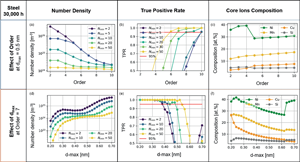No CrossRef data available.
Published online by Cambridge University Press: 21 September 2021

One of the main capabilities of atom probe tomography (APT) is the ability to not only identify but also characterize early stages of precipitation at length scales that are not achievable by other techniques. One of the most popular methods to identify nanoscale clustering in APT data, based on the density-based spatial clustering of applications with noise (DBSCAN), is used extensively in many branches of research. However, it is common that not all of the steps leading to the selection of certain parameters used in the analysis are reported. Without knowing the rationale behind parameter selection, it may be difficult to compare cluster parameters obtained by different researchers. In this work, a simple open-source tool, PosgenPy, is used to justify cluster search parameter selection via providing a systematic sweep through parameter values with multiple randomizations to minimize a false-positive cluster ratio. The tool is applied to several different microstructures: a simulated material system and two experimental datasets from a low-alloy steel . The analyses show how values for the various parameters can be selected to ensure that the calculated cluster number density and cluster composition are accurate.